#early medieval women
Text
the marvel how-can-i-shoehorn-more-stuff-about-medieval-queens-into-this-fanfiction universe
#'medieval' here used as a shorthand for a period that also covers early modern#that untitled sifki sequel may or may not have another 'btw her maids totally know her menstrual cycle' moment in it#i know the readers LOVE those#(they don't. i assume?)#and the frostmaster 'anne boleyn' thing is gonna open with a Very Tasteful bit of neck-admiring#i've actually been branching out a bit in my readings though. i even read one about a KING recently. one written by A MAN even :O#tho i still favour my kindle categories of 'dead queens (uk)' 'dead queens (not uk)' and 'historical women (not queens tho)'#see? i read upon diverse historical topics. (or 'divers' as the primary sources would have it.)#btw if anyone can rec a non-fiction book in english about wu zetian i'd be forever grateful thanks in advance
7 notes
·
View notes
Text
Identifying J.C. Walker's Illustrations
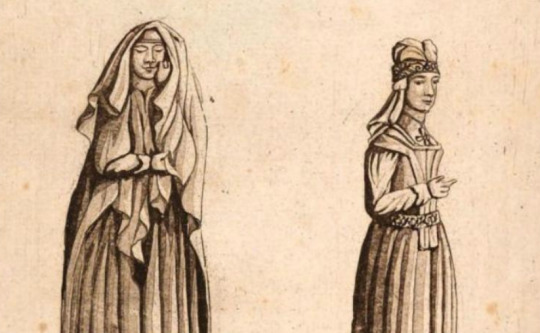
An Historical Essay on the Dress of the Ancient and Modern Irish by Joseph Cooper Walker published in 1788 was the first major work published on Irish dress history. Due to a combination of the limited information known at the time, and his erroneous assumption that Irish dress didn't change for the entirety of the Middle ages, Walker got a lot of things wrong, so his writing isn't cited much anymore. Some of his illustrations, however, are still used.
Because Walker lived before the invention of photography, he used drawings of historical Irish art created by colleagues and family to illustrate his book. I decided to track down the original works of art to see how Walker's drawings compared. I am resorting these into roughly chronological order, because Walker's lack of regard for chronology makes my head hurt.
The High Crosses, 9-10th centuries:
Ireland's high crosses have unfortunately lost a lot of their detail due to erosion, making these hard to identify. Sadly, the breeches with a fitted knee-band and the skirt gathered to a waistband look more Late Medieval or Early Modern than they do Early Medieval, so I don't think these are reliable depictions of the lost detail.
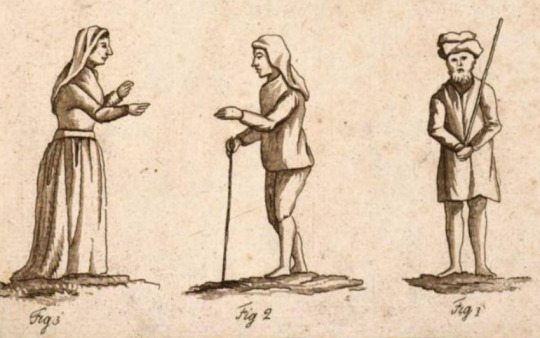
Plate 1: Figure 1 (right) is supposed to be from the Clonmacnoise Cross of Scripture. At a guess, it's based off the guard on the right arresting Jesus:
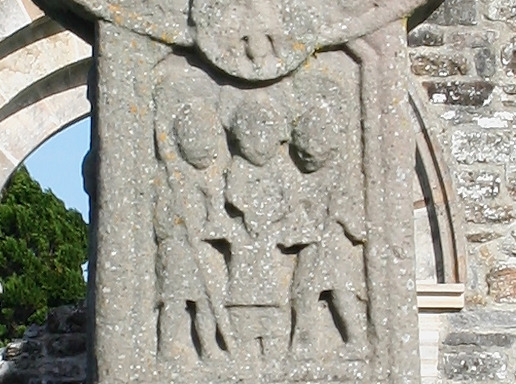
Figures 2 and 3 are based off a high cross fragment at Old Kilcullen, County Kildare. Unfortunately, I don't think the original carving survived. I initially blamed its loss on the United Irishmen, but this drawing from 1889 convinced me that acid rain was the real culprit.
Plate 5 Figure 1 is supposed to be a king from Muiredach's cross. The closest image I could find on the actual cross is Cain killing Able:

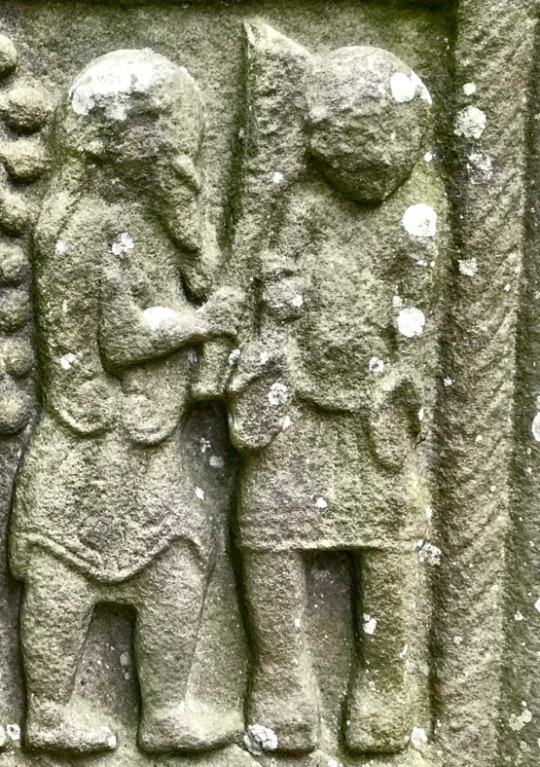
Ironically, Cain and Able have more embellishment on their clothes than the "king" based off of them.
12th century:
Plate 1 Figure 5 is from the capital of an arch at St. Saviour's Priory in Glendalough, County Wicklow. The drawing gives the impression that the sides of the head were shaved and the hair was deliberately curled at the end. In the actual carving, the hair is slicked back at the sides and interlaced with adjacent design elements. These are stylistic elements of Irish Romanesque art and not intended to be a realistic depiction of an Irish hairstyle.
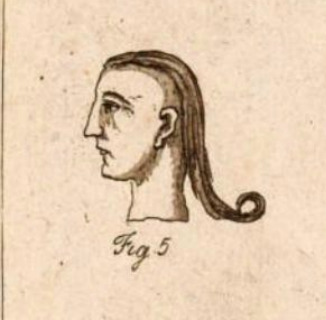

13th century:
Plate 4 is the late 13th century effigy of Felim O'Connor, Dominican Priory of St. Mary, Roscommon with a frontal of gallowglasses added in the 15th c.

This drawing is pretty accurate, although the gallowglasses are lacking some details like their quilted cloth gambesons.

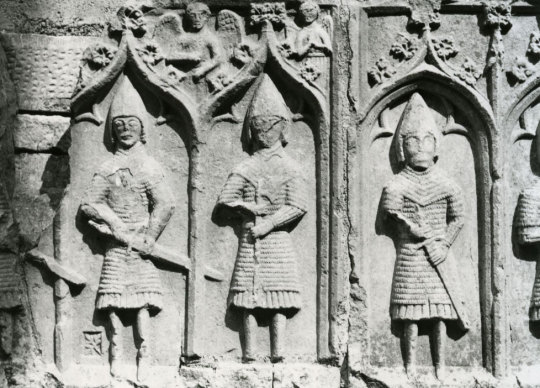
photos by Edwin Rae
I cannot find a good photo of Felim O'Connor's effigy, but Conor O'Brien's contemporary effigy at Corcomroe Abbey, County Clare wears the same style of clothing.
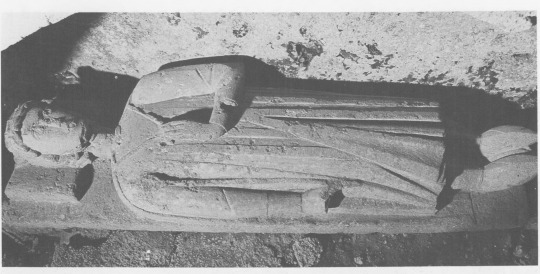
13-14th century?
Plate 6 is based on a sculpture from Athassel Priory in County Tipperary. I can't find a solid date for this one. Athassel Priory was built c1200 and then burnt and rebuilt twice before it was dissolved in 1541. The clothing style of the carving makes me think it's from the earlier part of this time frame.
The biggest thing the drawing gets wrong is the gender. This is a man, not a woman. The "necklace pendent" on his chest might have actually been a brooch holding his cloak, but the sculpture is now too damaged to tell. The drape of fabric at his side, which Walker calls a train, is actually the edge of his cloak. The drawing also leaves out the way his become more fitted below the elbow.
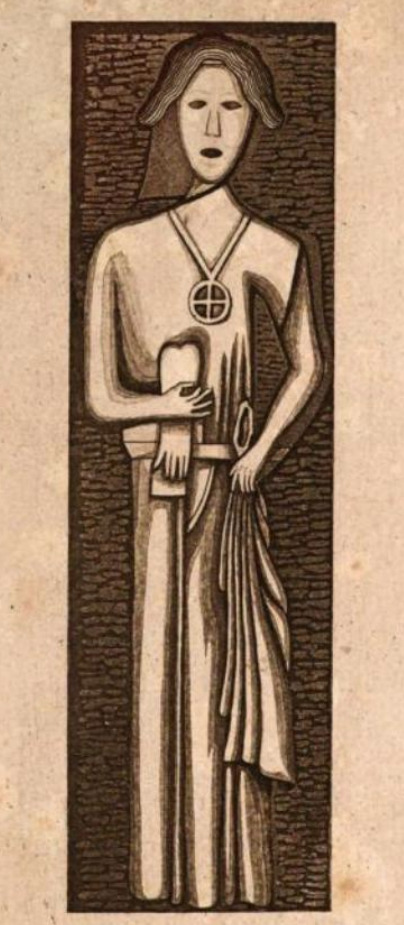

15th century:
Plate 3 Figures 1-3 are based off a painting at Knockmoy Abbey.

I'm pretty sure those are houppelandes on the left and center figures. This continental fashion influence shows up elsewhere in 15th c. Ireland (Dunlevy 1989). The drawing omits the massive houppelande sleeves and shortens their hems.

The painting is now badly weather and difficult to see. This is a more accurate drawing published in 1904. Recent photograph here
Plate 5 figure 2 and plate 1 figure 6 come from a 15th c. grave at the Dominican Friary, in Strade, County Mayo.
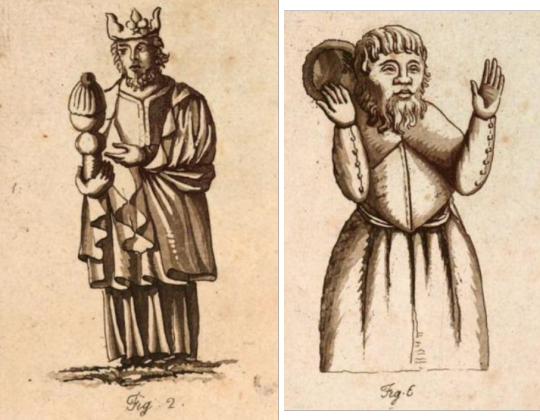
Figure 2 is a decent representation, although it adds a center front slit to the leine which I don't think is actually there. Figure 6 gets the silhouette of the cotehardie a bit wrong and omits the hanging belt accessories, but its greatest crime is that it makes the top of the hood look like a separate object. Walker actually misidenifies it as a Scotch bonnet.
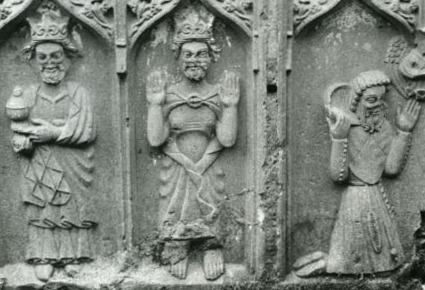
photo again by Edwin Rae
Plate 7 is Anne Plunket's effigy at St. Mary's Church, Howth, County Dublin. This drawing is decent, though the sleeves are a bit too slim. The cross necklace and belt decorations are no longer visible on the effigy.
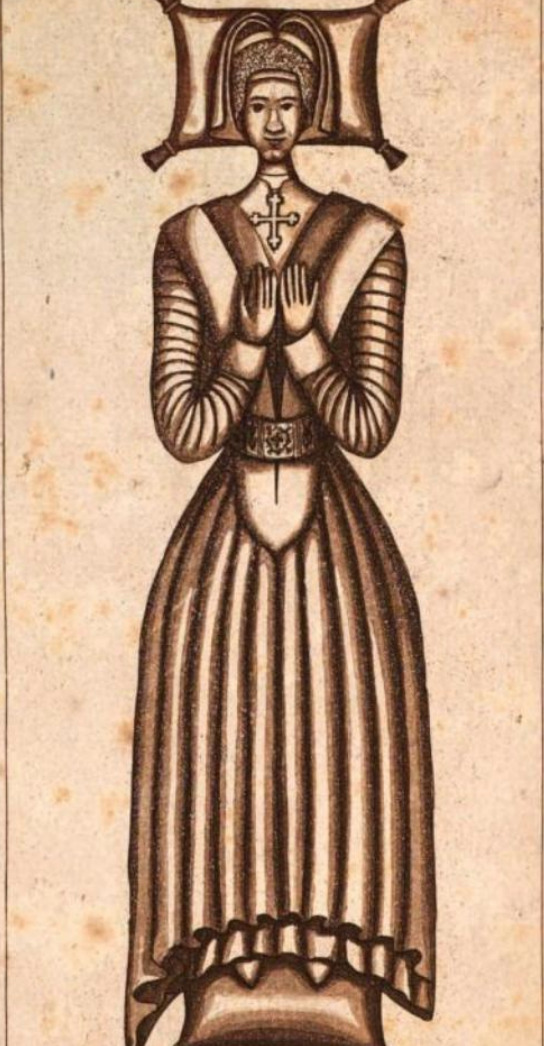
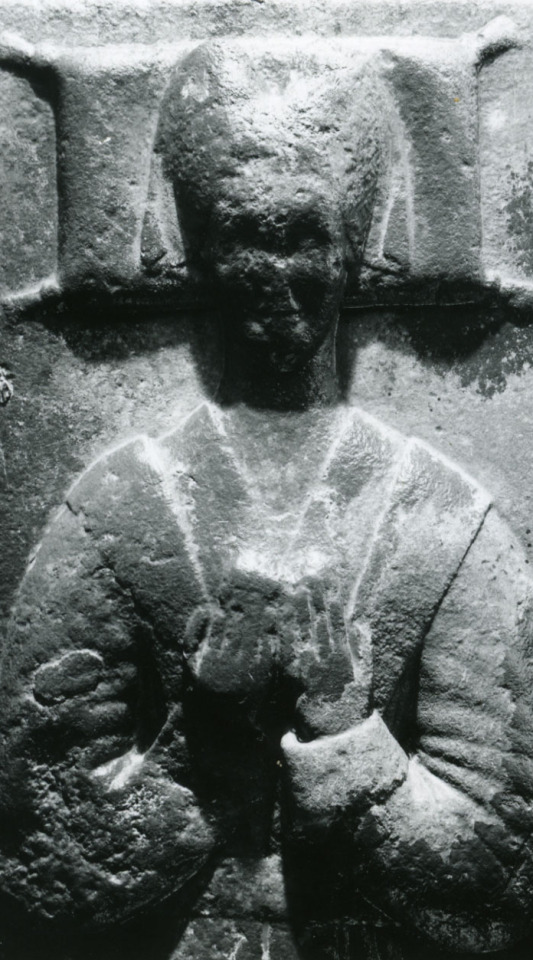
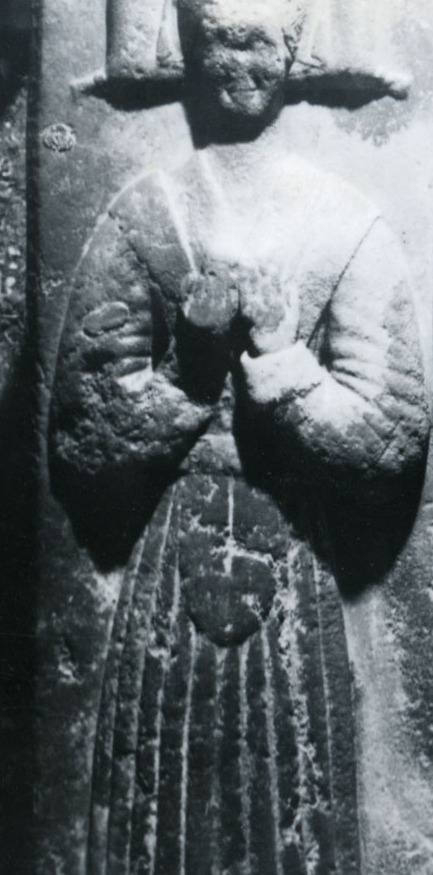
photos by MVP Edwin Rae
Plate 8 figures 1 and 2 are both based on a late 15th c. tomb at the New Abbey in Kilcullen, County Kildare. Figure 1 is based off a carving which is probably depicting St. Brigid, which makes her headwear the wimple of an abbess, not a laywoman's kerchief Walker. The drawing, however, omits her telltale crozier. The drawing makes it look like she has cuffed sleeves, but that is actually just the folds of her brat draped over her arm. It also shows her as wearing 2 layers of skirts when she is actually wearing a single lower garment with a hem circumference so large that it puddles at her feet.
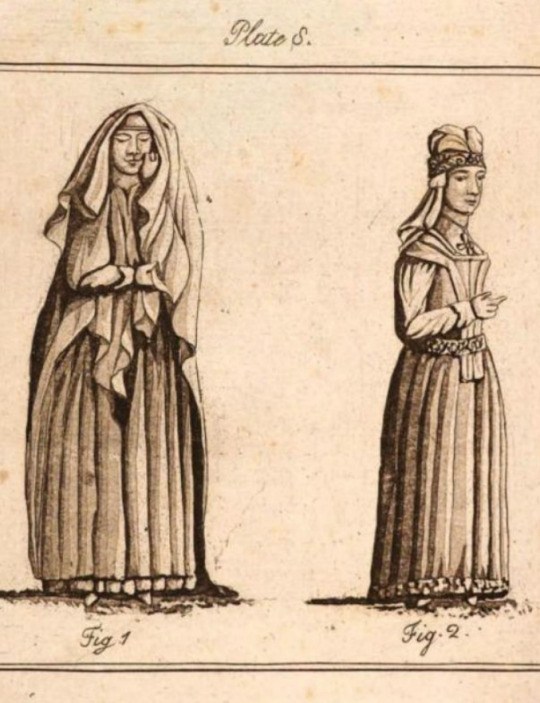

Figure 2 is based of Margaret Janico's effigy. The effigy is now too badly eroded to make out details, but it originally probably looked very similar to Margaret Janico's other effigy in St. Audoen's Church, Dublin. Unlike Anne Plunket's effigy above, the necklace and belt decorations are still faintly visible on the Dublin effigy. Figure 2 distorts the construction of the gown and headwear. This drawing makes the bodice of the gown look heavily stiffened or even boned like 17th c. stays. The houppelande on the effigy does not have stiffening in it.
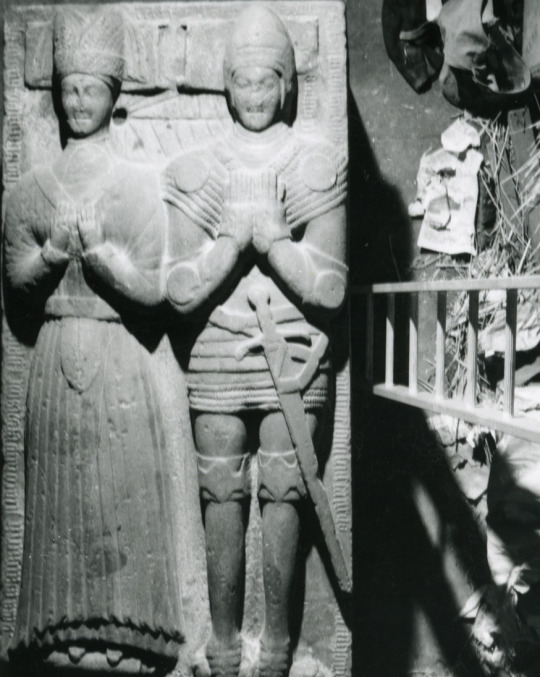
effigy of Margaret Janico and husband at St. Audoen's Church, Dublin (photos, once again, by my man Edwin)
The headpiece in the drawing looks like a linen kerchief wound up to form a turban with a decorated fillet tied over it. The headpiece on the effigy is probably actually a truncated hennin with a veil pinned to it like the one in this mid-15th c Burgundian painting by Petrus Christus.
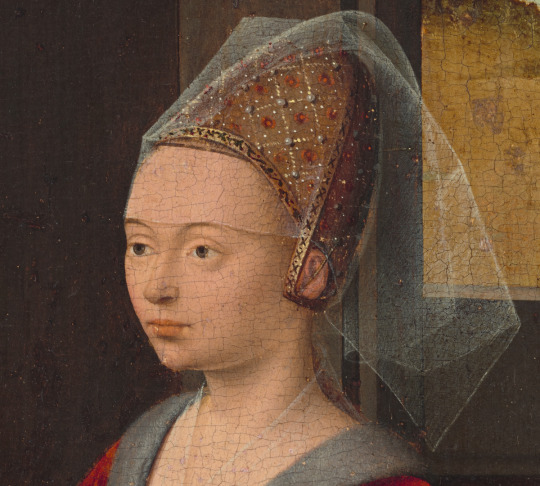
16th century:
Plate 9 is based on Katherine Molloy's early 16th c. effigy at Fertagh Church, in County Kilkenny. According to the artist's notes it was in "nearly perfect" condition at the time. I wish he had put more detail into the drawing.

(photo also by Edwin Rae)
17th century:
Plate 10 is based on The Taking of the Earl of Ormond in anno 1600. Walker's artist clearly fabricated some detail here, falsely giving the impression that triús were ankle-length. We know from extant examples from Kilcommon, Dungiven, and Killery that triús actually extended past the ankle, covering part of the wearer's foot (Dunlevy 1989, Henshall et al 1961).
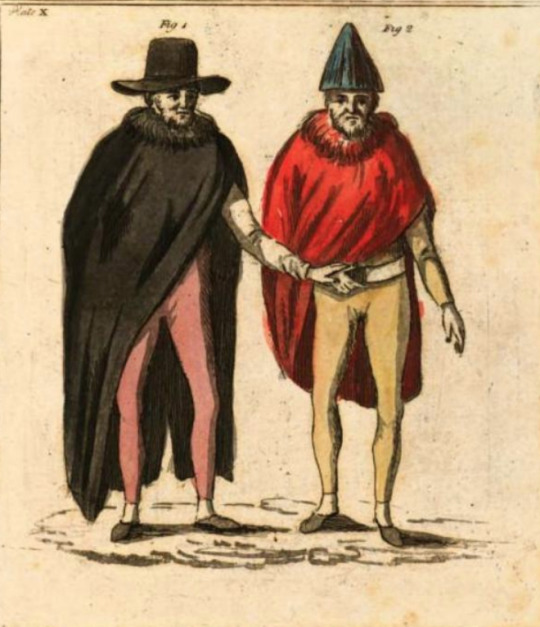

Plate 11 was taken from the tomb of Sir Gerald Aylmer (died 1634) and Juliana Nugent. Sadly, it appears to have been destroyed in the early 19th c, so I have no further pictures of it. The clothing looks to me like typical 1630s English fashion with loose gowns over doublets, falling bands, and linen cuffs.
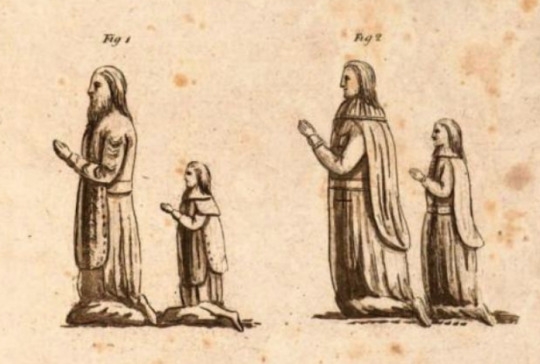
? Century
Plate 1 figure 4 is apparently from Old Kilcullen, County Kildare. I am not sure what this is based on. I haven't seen any Santa hats at Old Kilcullen. Or anywhere else in Medieval Ireland.
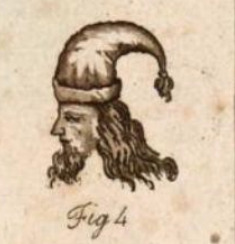
Bibliography:
Dunlevy, Mairead (1989). Dress in Ireland. B. T. Batsford LTD, London.
Henshall, Audrey, Seaby, Wilfred A., Lucas, A. T., Smith, A. G., and Connor, A. (1961). The Dungiven Costume. Ulster Journal of Archaeology, 24/25, 119-142. https://www.jstor.org/stable/20627382
Edwin Rae's invaluable collection of photographs of Late Medieval Irish art accessed via TARA.
#15th century#irish dress#dress history#irish history#art#early medieval#16th century#historical women's fashion#historical men's fashion#historical fashion#hiberno norman#gaelic ireland#headwear
11 notes
·
View notes
Photo
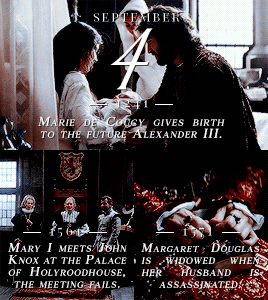
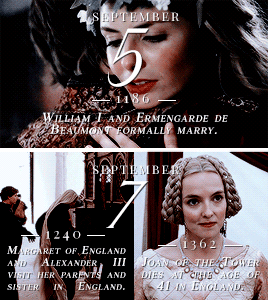


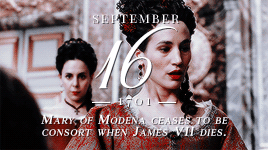
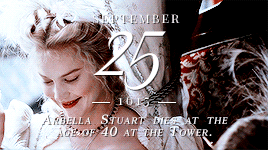
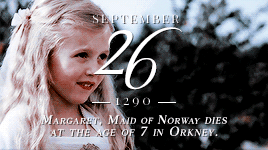
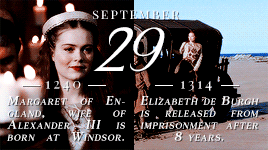
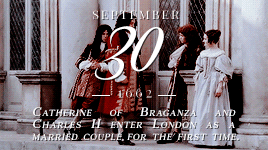
Scotland’s Ladies Month in History ✧ SEPTEMBER
#historyedit#history#on this day in history#scottish history#british history#medieval history#early modern history#kingdom of scotland#women in history#house of dunkeld#house of sverre#house of bruce#house of stewart#house of stuart#queen consorts#queens regnant#gifs#monthinhistory#ours
147 notes
·
View notes
Link
“Everyone loves a good villain. One who cackles at the sky and shakes their fist and brings some form of doom to something or someone. It is fun to have someone to root against and root for — especially if they have a fun, cosplay-worthy aesthetic. With all that goes into stanning our favorite villains of all time, there is something to be said about examining the superficiality of villainy.
Like many character types, villains have often been visually identifiable. They have some costume or way of moving or physical features that mark them as villains in the story. Villains look bad or evil. Villains just look like villains. This is where some of the problems start with who we assign villainy to in storytelling. A hero versus villain narrative is often an Us versus Them set up, with Us being on the side of the hero and Them being on the side of the villain.
I recognize that sympathetic villains have recently been on the rise. I, for one, have also argued there are more generous ways of interpreting villains from our literary past. Nevertheless, when we look at the big picture of villains, they are often the othered members of society who are wrong or bad or shunned.“
#THE SUPERFICIALITY OF VILLAINY#villain#book villains#hero versus villain#bad versus good#good and evil#sympathetic villains#book blog#book essay#medieval#early modern#VILLAINS AND ABLEISM#ANTISEMITISM AND THE VILLAIN#THE QUEER-CODED VILLAIN#RETHINKING WHAT OUR HEROES AND VILLAINS LOOK LIKE#we support women's wrongs#The Jasmine Throne by Tasha Suri#Iron Widow by Xiran Jay Zhao#Hench by Natalie Zina Walschots#That Time I Got Drunk and Saved A Demon by Kimberly Lemming#sensitivity readers#Who do we want our villains to be?
30 notes
·
View notes
Text
I'ma be real, when I first got to New England and heard people talking about alewives and that there was an alewife day and everything, I did not know they were talking about a fish, I simply assumed it was a Ye Olde tradition and everyone was just really down to celebrate the region's lady brewers
#Sword speaks#*me who knows about how important women were in the development of brewing in the medieval and early modern periods*#'Ah yes this makes sense. Good to see them carrying on that acknowledgement'
2 notes
·
View notes
Text
Hi
Hello,
I thought I'd do a little introduction about myself and the purpose of this blog. My name is Claudia and I have studied history at university. I'm starting this blog so I can publish researched articles on different, lesser known figures in history, from various eras. These will be approached from different angles, with a focus on social history and microhistory!
I'd love to research people from a variety of countries, backgrounds, time periods, generally those who've up to now been given less space in history books, and so if you have any suggestions of people that you might want to know more about, let me know in messages and I will add them to my list of article ideas. For example, Bessie Blount, Henry VIII's mistress!
Although I won't be posting directly about them, I also write historical fiction and love historical dramas; Medici Masters of Florence (Daniel Sharman?), Reign, Outlander, the Tudors, the Spanish Princess, and so many more
What are your historical areas of interest?
~ Claudia :)
#history#earlymodernhistory#university#ancient history#modern history#history blog#world history#women in history#15th century#middle ages#medieval#renaissance#16th century#1600s#17th century#victorian#edwardian#regency#early modern#earlymodern#ancient rome#ancient greece
12 notes
·
View notes
Text

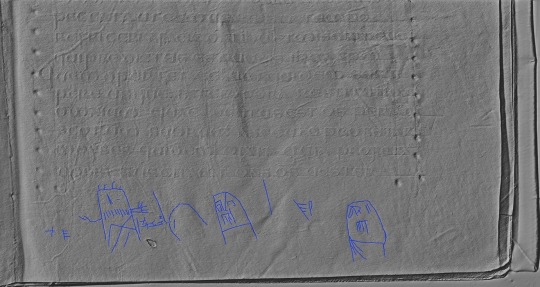
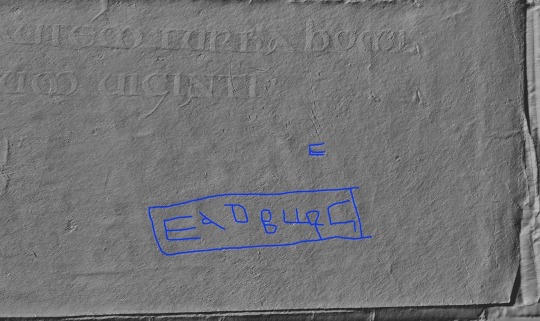
incredible doodles and signature done by a woman named eadburg identified in an early medieval english manuscript (acts of the apostles + nt compilation, 8th century, doodles assumed contemporaneous)!! look at those cool little guys
#i dont even know what to tag this i’m just significantly hyped so i’m posting it#they suggest she might be the scribe which i don’t think they have any evidence for but wcyd#it literally doesn’t matter she rules so much#also like this stuff is so rare. so rare and so delicious#there’s an inscription ‘ego ancilla tua’ (i am your handmaid) that’s been trotted out as like#theeeee example of women’s readership in early medieval england for so long#anyway i’m obsessed with them#history tag
7 notes
·
View notes
Text
The first gentle movements, when they came, were testament to the fact that a new life had begun. For as far as Tudors were concerned, life did not begin at conception…Life itself was deemed to begin when the soul entered the fully formed foetus, which occurred at 46 days for a boy and 90 days for a girl.
—Elizabeth Norton, The Hidden Lives of Tudor Women: A Social History, p. 1
#elizabeth norton#the hidden lives of tudor women#quote#medieval history#renaissance england#pregnancy#abortion#tudor dynasty#early modern english
14 notes
·
View notes
Text
“One of the most influential documents in the history of medieval scientific attitudes toward women”
654J pseudo Albertus Magnus
Albert(us) Magnus Secretis mulieru(m)
Leipzig : Melchior Lotter, 1500 $12,000
GW dates [c.1500].
Quarto 24 x 14.5 cm. Collation: A–F6, F6 is a blank, colophon on F5, verso.( f6 blank and present.) there are two variants of ISTC ia00313970 differing coalitions and typefaces. This copy is annotated throughout with what I suspect are class notes, or an instructor’s…

View On WordPress
#AlAlbetrus Magnus#De Secretis#early printed books#Malleus Maleficarum#Medical Misogyny#Medieval women#The Secrets of women#women&039;s menstrual blood
2 notes
·
View notes
Text
every time i see trad gender roles people being weird about fibercraft i wanna tell them
-medieval and early modern knitting guilds were full of men learning and perfecting fancy knitting techniques to impress rich clients
-in cold, wet climates like the scottish highlands knitting was done by the whole family, in fact it was the perfect activity to do while a man was out on a fishing boat or in the pasture with his sheep and cattle
-men who were away from women for a long time had to know how to knit and sew at least well enough to mend their own clothes. soldiers knitted. sailors knitted. cowboys and frontiersmen knitted. vikings probably knitted (actually they would have been doing a kind of proto knitting called nalbinding, but that's beside the point). all those guys the far right love to treat as ultra masculine heroes were sitting around their barracks and campfires at night darning their socks and knitting themselves little hats
21K notes
·
View notes
Text
Apparently they’re making ‘Hamnet’ into a film?
I’m torn about it. On the one hand, the book was beautifully written, and I did enjoy it overall.
On the other, there was a bit of a ‘not like other girls’ thread shot through it. And that’s not even about her mystical powers or whatever. It’s just, of course Agnes isn’t Christian, her mother and her never wear/don’t like hoods, she’s apparently the only woman in the town who’s good with herbs, and of course she hates the usual traditions around child birth and has to go off into the woods. Cumulatively, that’s… not great imo
There might even be more examples than that, but those are what I can remember off the top of my head having read it several years ago. Again, I thought it was good, well-written historical fiction and I liked it overall. But this was annoying to me, and honestly a shame
#I just hope it turns out to be good. but if there’s a similar theme through the film#I think that’d be a wee bit sad#can ordinary medieval/early modern women please get some respect one of these days#they’re always hard done by in historical dramas it feels like#and tbh. outside of them as well#hamnet#historical fiction#shakespeare#history#early modern history#period drama#historical drama
1 note
·
View note
Text
"Women's history has been erased in every period."
Michael Wood
In Search of the Dark Ages
1 note
·
View note
Text
Ngl I'm not having a great time being the only Visibly Queer person in these seminars. Not enjoying turning up wondering if I'm gonna have to debate my right to existence on the daily.
#like most people are cool don't get me wrong. very friendly. but the fear doesn't go away.#especially when queer things get brought up. todays seminar is on early medieval crossdressing (especially womens) and i just know i'm#gonna feel self conscious the whole time#and like. if i say anything its gonna be invalid because its gonna be assumed i can only see it from a modern queer pov#ugh. stress. and then in two days theres the seminar thats like. actually got people i've heard say outright transphobic stuff. fun times.#nate talks
1 note
·
View note
Text
So here's one of the coolest things that has happened to me as a Tolkien nut and an amateur medievalist. It's also impacted my view of the way Tolkien writes women.
Here's Carl Stephenson in MEDIEVAL FEUDALISM, explaining the roots of the ceremony of knighthood:
"In the second century after Christ the Roman historian Tacitus wrote an essay which he called Germania, and which has remained justly famous. He declares that the Germans, though divided into numerous tribes, constitute a single people characterised by common traits and a common mode of life. The typical German is a warrior. [...] Except when armed, they perform no business, either private or public. But it is not their custom that any one should assume arms without the formal approval of the tribe. Before the assembly the youth receives a shield and spear from his father, some other relative, or one of the chief men, and this gift corresponds to the toga virilis among the Romans--making him a citizen rather than a member of a household" (pp 2-3).
Got it?
Remember how Tolkien was a medievalist who based his Rohirrim on Anglo-Saxon England, which came from those Germanic tribes Tacitus was talking about?
Stephenson argues that the customs described by Tacitus continued into the early middle ages eventually giving rise to the medieval feudal system. One of these customs was the gift of arms, which transformed into the ceremony of knighthood:
"Tacitus, it will be remembered, describes the ancient German custom by which a youth was presented with a shield and a spear to mark his attainment of man's estate. What seems to the be same ceremony reappears under the Carolingians. In 791, we are told, Charlemagne caused Prince Louis to be girded with a sword in celebration of his adolescence; and forty-seven years later Louis in turn decorated his fifteen-year-old son Charles "with the arms of manhood, i.e., a sword." Here, obviously, we may see the origin of the later adoubement, which long remained a formal investiture with arms, or with some one of them as a symbol. Thus the Bayeux Tapestry represents the knighting of Earl Harold by William of Normandy under the legend: Hic Willelmus dedit Haroldo arma (Here William gave arms to Harold). [...] Scores of other examples are to be found in the French chronicles and chansons de geste, which, despite much variation of detail, agree on the essentials. And whatever the derivation of the words, the English expression "dubbing to knighthood" must have been closely related to the French adoubement" (pp 47-48.)
In its simplest form, according to Stephenson, the ceremony of knighthood included "at most the presentation of a sword, a few words of admonition, and the accolade."
OK. So what does this have to do with Tolkien and his women? AHAHAHAHA I AM SO GLAD YOU ASKED. First of all, let's agree that Tolkien, a medievalist, undoubtedly was aware of all the above. Second, turn with me in your copy of The Lord of the Rings to chapter 6 of The Two Towers, "The King of the Golden Hall", when Theoden and his councillors agree that Eowyn should lead the people while the men are away at war. (This, of course, was something that medieval noblewomen regularly did: one small example is an 1178 letter from a Hospitaller knight serving in the Latin kingdom of Jerusalem which records that before marching out to the battle of Montgisard, "We put the defence of the Tower of David and the whole city in the hands of our women".) But in The Lord of the Rings, there's a little ceremony.
"'Let her be as lord to the Eorlingas, while we are gone.'
'It shall be so,' said Theoden. 'Let the heralds announce to the folk that the Lady Eowyn will lead them!'
Then the king sat upon a seat before his doors and Eowyn knelt before him and received from him a sword and a fair corselet."
I YELLED when I realised what I was reading right there. You see, the king doesn't just have the heralds announce that Eowyn is in charge. He gives her weapons.
Theoden makes Eowyn a knight of the Riddermark.
Not only that, but I think this is a huge deal for several reasons. That is, Tolkien knew what he was doing here.
From my reading in medieval history, I'm aware of women choosing to fight and bear arms, as well as becoming military leaders while the men are away at some war or as prisoners. What I haven't seen is women actually receiving knighthood. Anyone could fight as a knight if they could afford the (very pricy) horse and armour, and anyone could lead a nation as long as they were accepted by the leaders. But you just don't see women getting knighted like this.
Tolkien therefore chose to write a medieval-coded society, Rohan, where women arguably had greater equality with men than they did in actual medieval societies.
I think that should tell us something about who Tolkien was as a person and how he viewed women - perhaps he didn't write them with equal parity to men (there are undeniably more prominent male characters in The Lord of the Rings and The Hobbit, at least, than female) but compared to the medieval societies that were his life's work, and arguably even compared to the society he lived in, he was remarkably egalitarian.
I think it should also tell us something about the craft of writing fantasy.
No, you don't have to include gut wrenching misogyny and violence against women in order to write "realistic" medieval-inspired fantasy.
Tolkien's fantasy worlds are DEEPLY informed by medieval history to an extent most laypeople will never fully appreciate. The attitudes, the language, the ABSOLUTELY FLAWLESS use of medieval military tactics...heck, even just the way that people travel long distances on foot...all of it is brilliantly medieval.
The fact that Theoden bestows arms on Eowyn is just one tiny detail that is deeply rooted in medieval history. Even though he's giving those arms to a woman in a fantasy land full of elves and hobbits and wizards, it's still a wonderfully historically accurate detail.
Of course, I've ranted before about how misogyny and sexism wasn't actually as bad in medieval times as a lot of people today think. But from the way SOME fantasy authors talk, you'd think that historical accuracy will disappear in a puff of smoke if every woman in the dragon-infested fantasy land isn't being traumatised on the regular.
Tolkien did better. Be like Tolkien.
#tolkien#middle earth#jrr tolkien#lord of the rings#lotr#the lord of the rings#eowyn#writing fantasy#fantasy#female characters#writing#historical fiction#medieval women#medieval history#medieval#history#womens history
8K notes
·
View notes
Link
Charlotte Cooper-Davis delves into the life and legacy of Christine de Pizan, a late medieval writer who was actively involved in the production of her own works. Speaking with Emily Briffett, Charlotte explores Christine’s vast catalogue of written work and how she has since become seen as a feminist icon.
#Christine de Pizan: from medieval writer to feminist icon#History Extra podcast#Christine de Pizan#medieval writer#feminist#Medieval women#medieval europe#Medieval history#podcasts#podcast#history#women writers#author interview#women in history#women's history#early feminist writers#feminist writing#feminist writers#feminism
0 notes
Text
Not sure quite how to phrase this, but I feel like there's sometimes implicit judgement of medieval and early modern women for being ill-educated.
Which is kinda funny because by the Tudor idea of 'a good education', the modern world is woefully under educated.
"Katherine Howard wasn't knowledgeable of the classics" and neither are you Stevie and you have Google.
3K notes
·
View notes